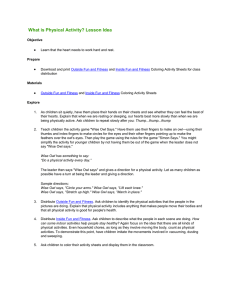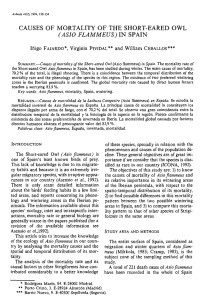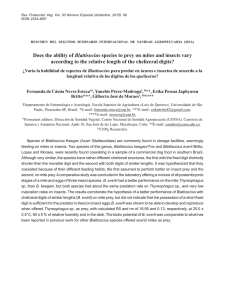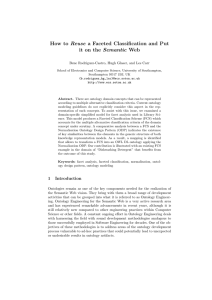Feeding strategy and predation of the Barn owl
Anuncio
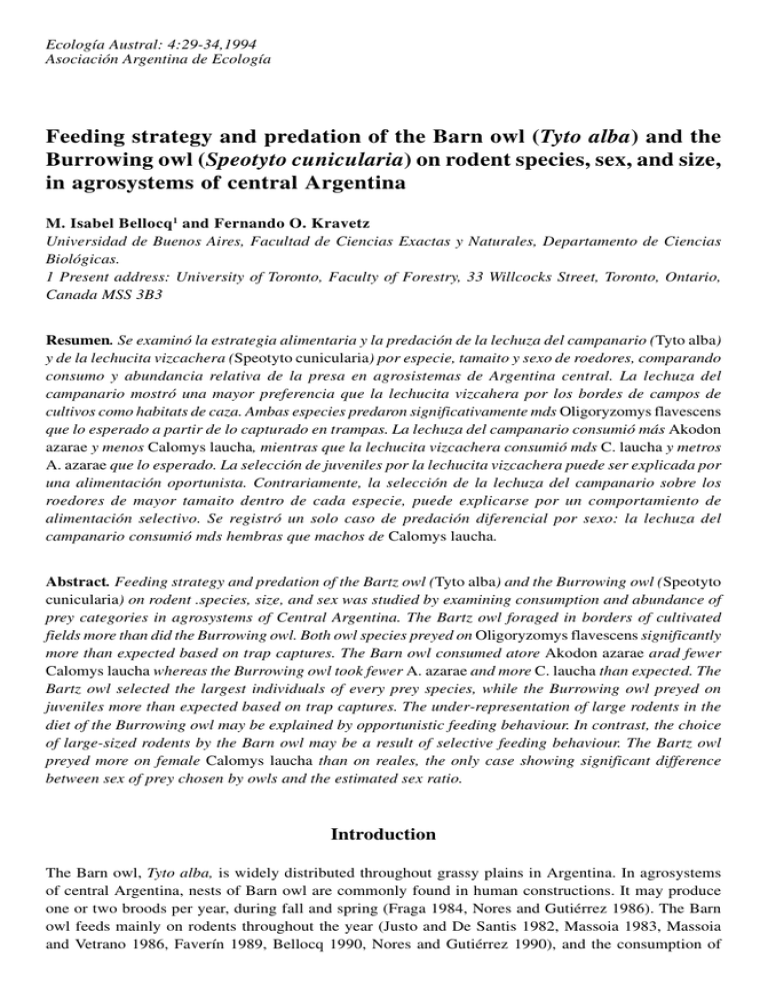
Ecología Austral: 4:29-34,1994 Asociación Argentina de Ecología Feeding strategy and predation of the Barn owl (Tyto alba) and the Burrowing owl (Speotyto cunicularia) on rodent species, sex, and size, in agrosystems of central Argentina M. Isabel Bellocq1 and Fernando O. Kravetz Universidad de Buenos Aires, Facultad de Ciencias Exactas y Naturales, Departamento de Ciencias Biológicas. 1 Present address: University of Toronto, Faculty of Forestry, 33 Willcocks Street, Toronto, Ontario, Canada MSS 3B3 Resumen. Se examinó la estrategia alimentaria y la predación de la lechuza del campanario (Tyto alba) y de la lechucita vizcachera (Speotyto cunicularia) por especie, tamaito y sexo de roedores, comparando consumo y abundancia relativa de la presa en agrosistemas de Argentina central. La lechuza del campanario mostró una mayor preferencia que la lechucita vizcahera por los bordes de campos de cultivos como habitats de caza. Ambas especies predaron significativamente mds Oligoryzomys flavescens que lo esperado a partir de lo capturado en trampas. La lechuza del campanario consumió más Akodon azarae y menos Calomys laucha, mientras que la lechucita vizcachera consumió mds C. laucha y metros A. azarae que lo esperado. La selección de juveniles por la lechucita vizcachera puede ser explicada por una alimentación oportunista. Contrariamente, la selección de la lechuza del campanario sobre los roedores de mayor tamaito dentro de cada especie, puede explicarse por un comportamiento de alimentación selectivo. Se registró un solo caso de predación diferencial por sexo: la lechuza del campanario consumió mds hembras que machos de Calomys laucha. Abstract. Feeding strategy and predation of the Bartz owl (Tyto alba) and the Burrowing owl (Speotyto cunicularia) on rodent .species, size, and sex was studied by examining consumption and abundance of prey categories in agrosystems of Central Argentina. The Bartz owl foraged in borders of cultivated fields more than did the Burrowing owl. Both owl species preyed on Oligoryzomys flavescens significantly more than expected based on trap captures. The Barn owl consumed atore Akodon azarae arad fewer Calomys laucha whereas the Burrowing owl took fewer A. azarae and more C. laucha than expected. The Bartz owl selected the largest individuals of every prey species, while the Burrowing owl preyed on juveniles more than expected based on trap captures. The under-representation of large rodents in the diet of the Burrowing owl may be explained by opportunistic feeding behaviour. In contrast, the choice of large-sized rodents by the Barn owl may be a result of selective feeding behaviour. The Bartz owl preyed more on female Calomys laucha than on reales, the only case showing significant difference between sex of prey chosen by owls and the estimated sex ratio. Introduction The Barn owl, Tyto alba, is widely distributed throughout grassy plains in Argentina. In agrosystems of central Argentina, nests of Barn owl are commonly found in human constructions. It may produce one or two broods per year, during fall and spring (Fraga 1984, Nores and Gutiérrez 1986). The Barn owl feeds mainly on rodents throughout the year (Justo and De Santis 1982, Massoia 1983, Massoia and Vetrano 1986, Faverín 1989, Bellocq 1990, Nores and Gutiérrez 1990), and the consumption of 30 M. I. Bellocq and F. O. Kravetz alternative prey showed weak seasonal changes (Bellocq 1988b). The Burrowing owl, Speotyto cunicularia, may be found in almost all grassy plains of Argentina, and it is the most abundant owl in agrosystems of central Argentina. In this habitat, most burrows are found in areas with relatively low disturbance, such as fields with no recent agricultural practices and borders of cultivated fields (Bellocq 1988b). Studies on the breeding biology of the Burrowing owl in Pampaen agrosystems showed egg-laying starts in early spring (Bellocq 1993). Chicks are fed mainly on insects and frogs. The Burrowing owl is a generalist predator in agrosystems of central Argentina. Its diet consists primarily of arthropods and small mammals (Coccia 1984, Bellocq 1988a), and shows strong seasonal changes in the consumption of alternative prey (Bellocq and Kravetz 1983a, Bellocq 1988a). Studies on predation of the Burrowing owl on small mammals in the Pampas showed that this predator took more juveniles and female Ctenomys talarum than expected based on trap captures (Pearson et al. 1968). Differential predation of the Burrowing owl by rodent species was linked to differential use of microhabitats among prey species (Bellocq 1987). Food selection depends on food preferences and feeding behaviour of predators and on vulnerability and relative abundance of alternative prey. Opportunistic predators take prey as they are encountered in the environment while selective predators take prey maximizing net energy intake (Griffiths 1975). Several factors affect vulnerability to predation between and within rodent species (activity patterns, plant coverage, use of microhabitats, social hierarchy, prey size, degree of activity, etc.). In this study, we examined feeding strategy and predation of the Barn owl and the Burrowing owl on rodents in agrosystems of central Argentina. We compare species, size, and sex of mice found in pellets with those trapped in the same area, and discuss possible causes of the differences between consumption and abundance of prey. Materials and Methods The study was conducted near Diego Gaynor, province of Buenos Aires, Argentina (34°18’S and 59’14’W). The area is devoted primarily to cereal crops with a few fields grazed by cattle. Two kinds of habitats, with different size, shape, degree of perturbation, and abundances of rodent species may be distinguished: 1) cultivated fields show low diversity of rodent species and suffer strong perturbations due to agricultural practices and have Calomys laucha as the most common rodent species; 2) borders of cultivated fields, extremely narrow habitats, show greater rodent and plant diversity than fields and have Akodon azarae as the dominant rodent species. Relative abundance of rodent species, size, and sex was estimated by livetrapping. Eighteen Sherman trap lines (with 10 to 20 stations and 1 to 3 traps per station) were set in cultivated fields and their borders. Traps operated from 1-7 June 1984, for a total of 1400 trap nights. More details on field methods may be found in Bellocq (1987). Captured mice were identified and classified into 3 groups according to their mass. Classes of mass were considered for C. laucha and A. azarae, respectively, as follows: Class 1 (juveniles), <9.0 g and < 15.0 g; Class 2 (medium-sized adults), 9.1-15.O g and 15.1-25.0g; and Class 3 (large-sized adults), > 15.0 g and >25.0 g (Bellocq 1988b). Several studies on population dynamics of rodents in agrosystems of central Argentina show similar seasonal patterns of relative abundance, age structure, and sex ratio, in different years (e.g., Crespo 1966, Pearson 1967, Kravetz et al. 1981, Zuleta et al. 1988). Therefore, the values of relative abundance of rodents obtained in this study were used to compare with those of consumption by predators in the same year as well as in subsequent years. Pellets were analyzed to determine the frequency of each rodent species, size category, and sex. During May and June, pellets were collected in nests and roosting sites within the trapping area. To examine Burrowing owl predation by rodent species, only pellets collected in 1984 (total 113) were considered (Bellocq 1987); and to examine predation by size and sex of rodents, 164 pellets collected in 1984 and 1985 were considered. Analyses on the Barn owl predation on rodents were based on 104 pellets collected in 1985 and 1986. Species, size category, and sex were identified from pellets using molars and pelvis (Bellocq and Kravetz 1983b). Regressions between body weight and tooth wear allowed to predict size categories of rodents found in pellets (Bellocq 1988b). Determination of size Feeding strategy of two owl species 31 category and sex was not possible in some cases because the molars were absent or the pelvis broken. Thus, it was not possible to study predation of the Burrowing owl by sex of A. azarae. χ2 tests of goodness-of-fit were conducted to test the absolute frequencies of occurrence of prey categories in pellets, against the hypotheses that those frequencies were similar to the relative frequencies of prey categories trapped in the area. Yate’s correction was used in cases with expected frequencies between 2 and 5 and in 2x2 tables. Manly’s alpha (Chesson 1978) was used to obtain food preferences where r; is the proportion of prey category i in the diet; ni is the proportion of prey category i in the wild; and m is the total number of prey categories considered. When selective predation does not occur, αi = m-1 (i = 1...m). If αi > m-1, then more of species i occurs in the diet than expected and if αi < m-1, less occurs than expected. Results Five species of rodents were found in pellets. Both species of owls fed on Calomys musculinus, C. laucha, A. azarae, and Oligoryzomys flavescens, whereas the Burrowing owl also fed on Mus musculus (Table 1). The frequencies of rodent species found in pellets were significantly different from the expected (considering only those ≥ 2) based on trap captures (χ2 = 259.611, P < 0.001, d. f.=2, and V =52.327, P<0.001, d. f.=2 for the Barn owl and the Burrowing owl, respectively), showing that both species of owls consumed more O. flavescens than expected. The Barn owl, however, consumed more A. azarae and fewer C. laucha, whereas the Burrowing owl took fewer A. azarae and more C. laucha than expected. The over-representation of A. azarae (dominant species in borders of cultivated fields) in the diet of the Barn owl suggests that this predator foraged more in borders than did the Burrowing owl. The observed frequencies of size categories of mice in the diet were different from the expected based on trap captures for both the Barn owl (χ2 =106.040 and χ2 =24.544, P < 0.001, d. f. =2, for C. laucha and A. azarae, respectively) and the Burrowing owl (χ2 =36.885, P<0.001, d. f.=2, and χ2 =9.198, P<0.02, d. f.=2, for C. laucha and A. azarae, respectively). Food preference indices showed that both species of owls preyed medium-sized mice in a lower proportion than expected according to their relative abundance (Table 2). The Barn owl took more large-sized adults than expected while juveniles were taken according to their relative abundance. In contrast, the Burrowing owl preyed more on juveniles than expected whereas large-sized adults were taken according to their relative abundance. The analysis of predation by sex showed the Barn owl preyed more on female C. laucha than expected based on the estimated sex ratio (χ2 =8.800, P < 0.01, d. f. =1) (Table 2). There was no significant difference in the choice of sex of A. azarae (χ2 =0.744, P > 0.1, d. f. =1). The Burrowing owl took male and female C. laucha according to the estimated sex ratio (χ2 =0.634, P>0.1, d-.f.=1). Discussion Selection of borders of cultivated fields as hunting habitat by the Barn owl in agrosystems was previously reported by Schulz (1986), who also pointed out the role of this kind of habitat in the reproductive success of the Barn owl. Selection of borders as hunting habitats by the Burrowing owl 32 M. I. Bellocq and F. O. Kravetz Table 1. Observed (t) and expected ( ) frequencies (%) of rodent species in the diet of the Barn owl (Tyto alba) and the Burrowing owl (Speotyto cuniculatia) in agrosystems of central Argentina. Table 2. Observed (t) and expected ( ) frequencies (%) of size categories and sex of Calomys laucha and Akodon azarae found in the diet of the Barn owl (Tyto alba) and the Burrowing owl (Speotyto cuniculatia) in agrosystems of central Argentina; and Manly’s food preference indices (αi=0.33, no preference; αi > 0.33, preference; αi < 0.33, avoidance). Class 1 : juveniles; Class 2: medium-sized adults; and Class 3: large-sized adults. in agrosystems of central Argentina was discussed in previous works (Bellocq and Kravetz 1983a, Bellocq 1987). Differences in hunting habitat between owl species may explain differences in diet composition (Jaksié and Yáñez 1980). The under-representation of C. laucha (dominant rodent species in open fields) in the diet of the Barn owl may be explained by a strong selection of borders as hunting habitat. Differences in species of rodents taken by both species of owls was unlikely the result of differences in predator/prey size ratio and handling capabilities. Although the Barn owl is larger than the Burrowing owl (mean body weight in North America 466 g and 155 g, respectively, according to Mueller, 1986), both species of predators are very large relative to the prey considered here. Mean body weight of cricetine rodents in Pampaen agrosystems ranges from 11.7 for C. laucha to 23.0 g for O. flavescens (Bellocq 1988b). Moreover, the Burrowing owl is capable of hunting on larger small mammal species such as C. talarum and Cavia aperea (Pearson et al. 1968, de Villafañe et al. 1988). Differences in activity patterns between predator and prey frequently explain differential predation on rodent species (e.g. Jaksié and Yañez 1979). However, all cricetine rodents in our study area are Feeding strategy of two owl species 33 primarily nocturnal (Crespo 1966). The Barn owl selection on rodent species within the borders is more likely related to microhabitat selection by prey than to any other factor. The use of microhabitat by rodents is different in borders (Bonaventura and Kravetz 1984), where O. flavescens and C. musculinus use microhabitats with less plant coverage than those used by A. azarae, making them more vulnerable to aerial predation. Differential predation on rodents by sex is usually associated either with sexually dimorphic prey or with different activity patterns between males and females. In general, variation in activity patterns occurs in relation to the breeding season. Because cricetine rodents are sexually monomorphic in the study area, and because this study was conducted during the non-breeding season, we did not expect to find selection by sex of rodents. Selection of rodents by size categories may be linked with differences in rodent vulnerability by age or social hierarchy. Generally, adult rodents (socially dominant) display territorial behaviour that decreases predation risk through increasing knowledge of the habitat and the ability to escape from predators (Metzgar 1967). In the same way, juvenile rodents would be more vulnerable to predation than adults. On the one hand, if social behaviour were the primary cause of low predation on medium-sized rodents, juveniles would be over-represented in the diet. However, only the Burrowing owl preyed more on juveniles than expected. On the other hand, if predators chose rodents primarily on the basis of energy intake, the largest rodents would be selected. However, only the Barn owl selected large-sized mice. Therefore, these owl species appear to have different feeding strategies when preying on mice. The Burrowing owl choice of juvenile mice may be explained by the high vulnerability of juveniles, supporting the argument of an opportunistic feeding behaviour. In contrast, the choice of large-sized rodents by the Barn owl may result from a maximization of the net energy intake, supporting the criterion of a selective feeding behaviour when preying on mice. Previous studies yielded contrasting results for owl predation on body size categories of rodents. For example, Fulk (1976) described cases where the Barn owl preferentially took large rodents, whereas Saint Girons (1973) reported this species did not select rodents according to size. In contrast with our results, Pefaur et al. (1977) observed that the Burrowing owl avoided small-sized Akodon olivaceus and selected adults. Feeding strategies of owls and their causes and consequences are varied, emphasizing the importance of local studies. Acknowledgments. We thank M. Busch and S.M. Bonaventura for their assistance in field work and M.D. Engstrom for thoroughly reviewing the manuscript. The authors and study were supported by the Consejo Nacional de Investigaciones Cientificas y Técnicas of Argentina. The preparation of the manuscript was supported by the Northern Ontario Development Agreement (Canada) and the Forestry Canada Green Plan. References Bellocq, M.I. 1987. Selección de habitat de caza y depredación diferencial de Athene cunicularia sobre roedores en ecosistemas agrarios. Rev. Chilena Hist. Nat., 60:81-86. Bellocq, M.I. 1988a. Dieta de Athene cunicularia (Aves, Strigidae) y sus variaciones estacionales en ecosistemas agrarios de la Pampa, Argentina. Physis, Secc. C. 46:17-22. Bellocq, M.I. 19886. Predación do roedores por ayes en ecosistemas agrarios. Tesis Doctoral, Univ. Buenos Aires. Bellocq, M.I. 1990. Composición y variación temporal de la dieta de Tyro alba en ecosistemas agrarios pampeanos. Argentina.Vida Silvestre Neotr. 2:32-35. Bellocq, M.l. 1993. Reproducción, crecimiento y mortalidad de la lechucita vizcachera (Speotyto cunicularla) en agrosistemas pampeanos. Hornero 13:272-276. Bellocq, M.l. and F.O. Krayetz. 1983a. Algunos rasgos de la predación de Athene cuniculaila sobre los roedores en agroecosistemas pampeanos argentinos. IX Congr. Latinoam. Zool., I Simp. Ornit. Neotr., Arequipa, Perú, 55-60. Bellocq, M.I. and F.O. Kravetz. 19836. Identificación de especie, sexo y edad relativa a partir de restos oseos de roedores de la provincia de Buenos Aires, Argentina. Hist. Nat. (Argentina) 3:101-112. Bonaventura, S.M. and F.O. Kravetz. 1984. Relación roedor-vegetación: estudio preliminar. Rev. Museo Arg. Cieno. Nat. Bernardino Rivadavia 13:445-451. Chesson, J. 1978. Measuring preference in selective predation. Ecology 59:211-215. Coccia, M. 1984. Observaciones ecológicas sobre Athene cunicularia partridgei, Olrog 1976, en pastizales inundables de la albúfera de Mar Chiquita (provincia de Buenos Aires). Seminario de Licenciatura, Univ. Nac. Mar del Plata. Crespo, J. 1966. Ecología de una comunidad de roedores silvestres en el partido de Rojas, Provincia de Buenos Aires. Rev. 34 M. I. Bellocq and F. O. Kravetz Museo Arg. Cienc. Nat. Bernardino Rivadavia 1:79-134. De Villafañe, G., S.M. Bonaventura, M.1. Bellocq, and R.E. Percich. 1988. Habitat selection, social structure, density, and predation in populations of Cricetine rodents in the Pampa region of Argentina, and the effects of agricultural practices on them. Mammalia 52:339-359. Faverín, C. 1989. Variación de la dieta de la lechuza del campanario (Tyto alba) en Lobos, provincia de Buenos Aires. Seminario de Licenciatura, Univ. Nac. Mar del Plata. Fraga, R.M. 1984. Casos de nidificación otoño-invernal en algunas rapaces (Tyto alba, Asio clamator, Elanus leucurus) en Lobos, Buenos Aires. Hornero 12:193-195. Fulk, G.W. 1976. Owl predation and rodent mortality: a case study. Mammalia 40:423-427. Griffiths, D. 1975. Prey availability and the food of predators. Ecology 56:1209-1214. Jaksié. J.M. and J.L. Yáñez. 1979. The diet of the Barn Owl and its relation to the availability of prey. Auk 96:619-621. Jaksié, J.M. and J.L. Yáñez. 1980. Differential utilization of prey resources by great horned owls and barn owls in Central Chile. Auk 97:895-896. Justo, E.R. and L. De Santis. 1982. Alimentación de Two alba en la provincia de La Pampa 1 (Strigiformes, Tytonidae). Neotrópica 28:83-86. Kravetz,F.O., C. Manjón, M. Busch, R. Pereich, P. Marconi and M.P. Torres. 1981. Ecología de Calontys lancha (Rodentia. Cricetidae) en el departamento de Río Cuarto (Córdoba) I. Dinámica de población. Ecología 6:15-22. Massoia, E. 1983. La alimentación de algunas aves del orden Strigiformes en Argentina. Hornero 12:125-148. Massoia, E. and A.A.S. Vetrano. 1986. Análisis de regurgitados de Tyto alba del molino de Forclaz, Colón, provincia de Entre, Ríos. Acintania 20:24-26. Metzgar, L.H. 1967. An experimental comparison of screech owl predation on resident and transient white-footed mice (Peromyscus leucopus). J. Mamm. 48:387-391. Mueller, H.C. 1986. The evolution of reversed sexual dimorphism in owls: an empirical analysis of possible selective factors. Wilson Bull. 98:387-406. Nores. A.I. and M. Gutiérrez. 1986. Nidificación de Tyto alba en Córdoba, Argentina. Hornero 12:242-249. Nores, A.I. and M. Gutiérrez. 1990. Dicta de la lechuza del campanario (Tyco alba) en Córdoba, Argentina. Hornero 13:129-132. Pearson, O.P. 1967. La estructura por edades y la dinámica reproductiva de una población de roedor de campo, Akotlon azarae. Physis, Secc. C. 27:53-58. Pearson, O.P., N. Binsztein, L. Boiry, C. Busch. M. Dipace, G. Gallopin, P. Penchaszaden and M. Piantanida. 1968. Estructura social, distribución espacial y composición por edades de una población de tuco-tucos (Ctenomys talar un). Invest. Zool. Chilenas 13:47-80. Pefaur, J., F.M. Jaksié and J. Yáñez. 1977. La alimentación de Speotyto cuniculatia (Aves: Strigiformes) en la provincia de Coquimbo. An. Mus. Hist. Nat. Valparaíso, Chile 10:179-183. Saint Girons, M.C. 1973. L’âge des micromammiferes dans le régime de deux rapaces nocturnes, Tyto alba et Asio otus. Mammalia 37:439-456. Schulz T.A. 1986. The conservation and rehabilitation of the common barn owl (Tyro alba). Sym. Manage. Birds of Prey, Sacramento, U.S.A. Zuleta. G.A., F.O. Kravetz, M. Busch and R.E. Pereich. 1988. Dinámica poblacional del ratón del pastizal pampeano (Akotlon azarae) en ecosistemas agrarios de Argentina. Rev. Chilena Hist. Nat. 61:231-244. Recibido: 29/4/93 Aceptado: 15/12/93

